Get on down to Chinatown. Good Food recipe writer and Billy Kwong owner-chef Kylie Kwong shares her beginners' guide to Chinese pantry staples.
Six pantry essentials to start
Kylie Kwong's absolute bare basics for beginners are:
Light soy sauce: "Light soy sauce is what we use in the majority of stir-fries, Chinese soups, steamed dishes, wonton and dumpling fillings, pickles and all sorts of things." (Kwong recommends Kikkoman light soy; she uses an organic tamari in her restaurant.)

Peanut oil: or some type of vegetable oil, if not peanut oil, for stir-frying; a good neutral-flavoured oil that works well at high heat.
Brown and white sugar: "Just a little bit here and there in stir-fries and braises. I use brown sugar because I love the caramel note that it creates. The only time I use white sugar – which still is essential in the Chinese kitchen – is when I'm doing classic Cantonese dishes such as steamed fish with ginger and shallots or white-cooked chicken. You sprinkle a bit of of white sugar on the top of the fish or chicken before scalding the entire dish with hot peanut oil. I use white sugar in these dishes because brown sugar is a bit too heavy and rich. I also use white sugar when I am pickling."
Shao hsing (Chinese cooking wine): "If you don't have Chinese cooking wine you can use sherry or a splash of last night's white wine. My mum has always used dry sherry."
Vinegar: "Whether that's malt vinegar, white vinegar or Japanese rice wine vinegar – you need some kind of sour acidic agent." In the restaurant, Kwong's go-to is an organic brown rice vinegar.
Sesame oil: a few drops act as a flavour enhancer.
"If you have those six ingredients – even if you don't have sesame oil – you can absolutely make the most successful stir-fry." See Kwong's stir-fry 101 below.

Neil Perry's red-braised pork belly (Recipe here). Photo: William Meppem
Next level
When you're ready to take your Chinese cooking to the next "foodie, foodie" level, try these additions:
Dark soy sauce: Dark soy sauce is aged longer than light soy sauce and mixed with molasses, which gives it a dark, caramel colour. Best for marinades, stocks and braises.
Chinese salted fermented black beans: These small soy beans are preserved with salt and spices which gives them their distinctively salty, rich taste and pungent smell. Kwong says the beans have an affinity with seafood and rich meats. "Stir-fried mud crab with black bean and chilli always features at our special family gatherings. At Billy Kwong, we dress deep-fried silken tofu with black bean and chilli sauce, which works really well as a vegetarian dish."
Cassia bark or cinnamon quills
Star anise
Five-spice: "I love five-spice, it's so exotic, so versatile. It's got those wonderful five to seven spices in it: cinnamon, star anise, fennel seeds, cloves, licorice root, Sichuan peppercorns and ginger. If you are time-poor, I'd be buying five-spice powder." Great for stocks and marinades.
Yellow rock sugar: Also known as golden crystal rock sugar, this sugar comes in the form of large crystals and is available from Asian grocers, look for the yellow cardboard box. Kwong uses this sugar not only for depth of flavour but she loves the "demi-glace look" and sheen it gives to stocks and red-braised dishes.
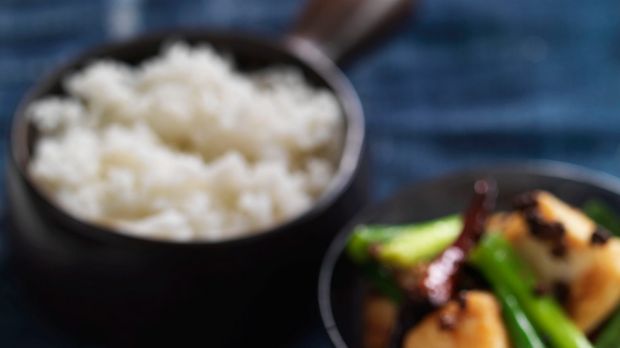
Neil Perry's stir-fried blue-eye trevalla with peanuts and Sichuan peppercorns. Photo: William Meppem
Sichuan peppercorns: Be warned, those tongue-tingling, lip-numbing peppercorns are potent. "They are intensely aromatic with a charming woody fragrance, but if you bite into a whole Sichuan peppercorn it can be quite affronting and quite unpleasant with its anaesthetic type effect." Be sure to pick them out once they've been used to flavour a Sichuan-style dish such as this fish stir-fry (pictured above). Alternatively, dry-roast and "throw them into your stocks, and yes, they make a difference, they add a really beautiful and deep, smoky dimension to it". Kwong also grinds dry-roasted Sichuan peppercorns together with salt flakes to use as a seasoning.
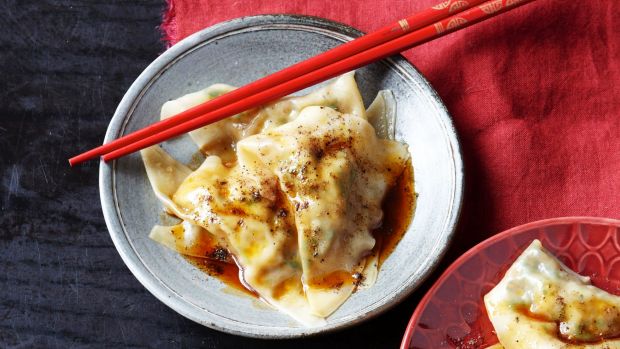
Wontons with Kylie Kwong's chilli oil. Photo: Vanessa Levis
Chilli flakes (for chilli oil): to make your own chilli oil, Kwong heats vegetable oil and infuses it with dried chilli flakes for a few hours, before straining. "You can use fresh chilli as well, but the dried chilli flakes give a really smoky, mysterious note." Drizzle over dishes or use in a Sichuan-style dressing. Kwong reserves the strained chilli flakes to use as a garnish or flavour boost. Kwong's fellow Good Food recipe contributor/writer Neil Perry is a fan of salted chillies; see his recipe here.
Dried scallops and shrimp: for those who wish to venture into XO sauce (see below). Dried scallops are a delicacy and can be sourced at selected Asian dried scallop and abalone stores. "I like to use high-quality Japanese dried scallops."

Jill Dupleix's pipis in XO sauce. Photo: Fiona Morris
XO marks the spot
Kwong warns that making XO sauce is "not for the faint-hearted" – be prepared to dedicate half a day to make a batch, after soaking the dried seafood. However, the umami-rich sauce should not be reserved only for special dishes, Kwong says: "you can just have a bowl of steamed rice with a fried egg and XO sauce on the top and you're just so happy." DIY and try Neil Perry and Jill Dupleix's XO recipes.

Ingredients for soy master stock – garlic, cinnamon sticks, spring onions, dried mandarin peel, ginger, star anise and yellow rock sugar. Photo: Marina Oliphant
Mastering master stock
If you've dedicated a weekend to making XO sauce, why not make master stock, too? The delicately spiced stock is generally flavoured with citrus peel, star anise, cinnamon, ginger and onion, and can last for many years and improves with age. "You make the master stock, then you poach the chicken, pork belly, duck or whatever it is that you want. Once you have finished, you strain your master stock, place in an airtight container and freeze until you are ready to use it again. Having master stock in the freezer is like having money in the bank. If you look after it well, your master stock can last for years," Kwong says. Try Brigitte Hafner's recipe here.
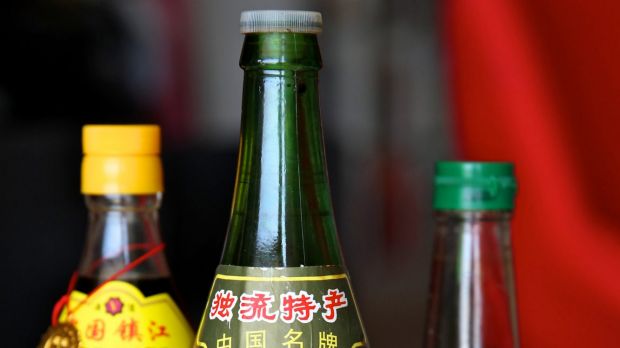
Chinkiang or black vinegar. Photo: Edwina Pickles
Getting sticky with it
Sauces
"I very rarely use any of those bottled, processed Asian condiments." Instead, Kwong prefers to make her own sauces, with red miso paste and rice syrup standing in for hoisin; garlic, honey, five-spice, tamari and olive oil as a natural alternative to Chinese barbecue sauce; and of course, her famous Billy Kwong chilli sauce. Click here for a guide to classic sauces, such as oyster, barbecue, hoisin and more.
Dipping sauces
Chinkiang or Chinese black vinegar is traditionally served with steamed dumplings, and Chinese red vinegar is paired with delicate seafood dim sum such as scallop siu mai or prawn har gau. Kwong prefers a punchy chilli sauce and soy (or tamari) alongside more "robust" dumplings and buns.
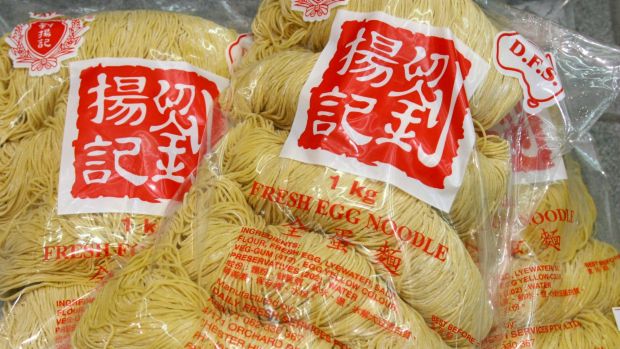
Kwong treats fresh egg noodles as she would fresh pasta. Photo: Jane Dyson
Dry goods
Rice: Kwong tends to use a medium-grain jasmine rice. "I like its moist, tender, slightly chewy texture, it is also really delicious to reuse the next day in fried rice."
Flour: For making bao or wontons, plain or strong bread flour should suffice. See Dan Lepard's steamed bao recipe here.
Noodles: When it comes to egg noodles, Kwong says to treat them as you would fresh pasta."Go to Chinatown, look on those shelves – there's all sorts of types now, there's the thin egg noodles, the Hokkien noodles, the Shanghai noodles – buy the fresh ones like you're buying fresh pasta. Take them home and blanch them yourself, just as you do with fresh pasta, and then put them into a stir-fry or soup."
Hokkien noodles are readily available at supermarkets, as are silken tofu and wonton wrappers, however Kylie loves going to Chinatown and sourcing fresh egg noodles. Dried egg noodles make a fine substitute.

Bargain: bamboo steamer baskets. Photo: Rebecca Hallas
Get on down to Chinatown
Once you've hit the Asian grocery store shelves, stocked up on spices and raided the refrigerated section for silken tofu, wonton wrappers and noodles, grab an affordable steamer and a wok.
Steamer
Kwong prefers traditional bamboo steamers over steam settings in modern ovens. She also suggests investing in an aluminium steamer set which will set you back about $25 and last longer than a bamboo basket. A steamer is essential for making dishes such as steamed fish with ginger and shallots and traditional dim sum.
Wok
Look for a wooden-handled, flat-bottomed wok, which will have an increased surface area directly over the heat. "The more surface area you have in the base, the better the stir-fry is going to be, because there's more heat coming through."
A note on seasoning: contrary to popular belief, "you do not have to have the wok turning black to begin using it," Kwong insists. Simply wash the new wok in warm, soapy water, using a non-stainless steel scourer to remove any sticky film. Dry off and it's good to go.
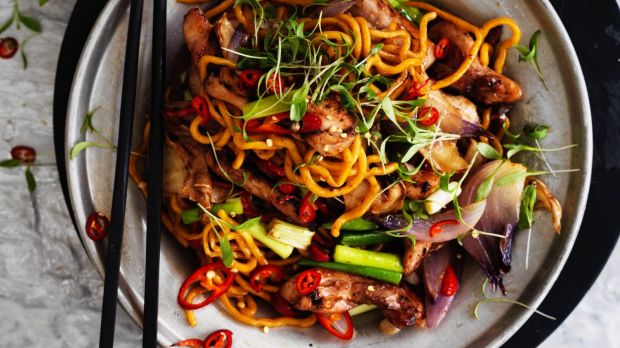
Stir-fried Hokkien noodles with chicken, chilli and coriander. Photo: William Meppem
Step-by-step stir-fry
Having watched her mother's wok skills like a hawk, Kwong's stir-fry rhythm and ratio is as follows.
Get a wok or heavy-based pan over a high heat, "absolutely as high as the stove can go", then add:
1. Oil – peanut or vegetable-based.
2. Aromatics – eg. sliced ginger, crushed garlic.
3. Vegetables and/or protein – the order of which will depend on how long each item takes to cook.
4. Shao hsing wine or alcohol – swirl for five seconds to cook off the alcohol.
5. A little bit of sugar – to caramelise the ingredients.
6. Stock or water – to add volume to the sauce.
7. Soy sauce – to balance the sweetness.
8. Vinegar – to add another dimension so you have sweet, salty and sour.
9. Sesame oil - just a drop to finish.
"I want to get the very best out of each ingredient and to create an overall, well-balanced dish. This can be achieved through understanding the individual characters of each ingredient. How do I bring out the full bloom and scent of the ginger and the garlic aromatics? How do we maintain the freshness and crispness of snow peas when stir-frying? How do we retain the moisture and tenderness when cooking chicken thigh fillets? How do we cook with sugar in order to draw out depth and caramelisation, and then how do we balance this sweetness with soy? This is why I do my stir-frying technique in a very specific order. It makes sense to me."
Kwong's cooking philosophy can be applied to many dishes beyond stir-fries.

Steamed snapper with ginger and green onions is a Cantonese classic. Photo: William Meppem
Note: This is by no means a definitive guide to Chinese cooking, rather a beginner's guide to pantry essentials. Kwong's family background is Cantonese, and she has included a few flourishes from regional cuisines such as Sichuan peppercorns. Chinese cuisine reflects the geographies of the country's provinces, so treat this list as a starting point. Build your own banquet with the recipes in the gallery above.
















































































Comments